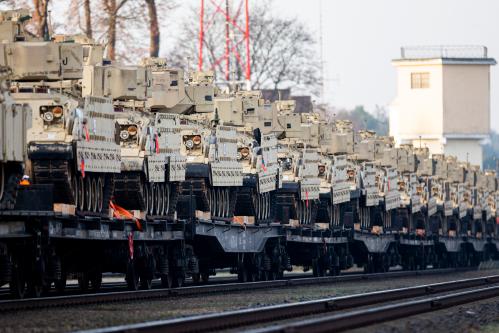The U.S. Department of Defense’s (DOD) Replicator initiative is not the machine used in the “Star Trek: The Next Generation” series to create food, spare parts, or oxygen on starships and help their crews “boldly go where no one has gone before.” This Replicator is the department’s initiative to thwart the People’s Republic of China’s (PRC) asymmetric advantage in weapons capability and overwhelming numbers in all domains (land, air, maritime, space, and cyberspace) through the application of many, small, “attritable” weapons and combat platforms. When employed as part of the joint fight, these assets will offset the capability and capacity advantages of the PRC and other U.S. adversaries.
Replicator poses an opportunity for the U.S. Army to continuously transform concepts, capability, and capacity while simultaneously innovating the application of multidomain landpower to offset the advantages of our critical pacing and acute threats. As the character of war changes, the Army should optimize the opportunity to increase the innovative mindset and help operationalize DOD’s ideas for more agile acquisition and procurement. An Army concept to use small, smart, cheap, and attritable unmanned systems to out-think, out-sense, out-maneuver, out-target, and out-sustain our adversaries will help operationalize any future Replicator initiative.
The Replicator initiative
In August 2023, Deputy Secretary of Defense Kathleen Hicks announced the initiative to develop and “field attritable autonomous systems at scale of multiple thousands, in multiple domains, within the next 18-to-24 months.” This announcement served several purposes and addressed multiple constituencies. First, it was a call to U.S. technology companies, regardless of size, to come forward in the current “commercial innovation ecosystem” to compete and help fulfill the conceptual requirements and opportunities developing in the changing character of war. Second, it was an open announcement to the PRC and other adversaries that the United States is actively competing below the level of armed conflict to offset some of their key advantages. Third, it is a notice for the DOD to find ways to adapt and innovate processes for defense acquisition. Finally, it is a call to the military services to begin developing concepts and adapting doctrine to implement systems at scale to offset all adversaries by using many unmanned systems in multiple domains. While current and future warfighting concepts and capability development are inherently joint, this opportunity should be a clarion call to the Army as it develops the concepts, capability, and capacity that integrate into the Replicator initiative and help the joint force fight and win.
Army requirements and opportunities within Replicator
Two near-term Army requirements are to develop a conceptual framework for using “offsetting” Replicator-type capabilities and then to focus production on the most critical areas immediately.
First, as the Army reviews the concept for multidomain land warfare for 2030 and beyond, it must adapt the supporting framework to account for how it might use many low-cost, autonomous, attritable systems at the theater, corps, division, and brigade levels. It should identify which systems to produce and how they could be used by different command echelons to shape the operational environment. It should define what roles, requirements, and capabilities are held at theater-level commands, the tactical corps, and the division level. Additionally, it may be helpful to highlight tactical scenarios where many small, cheap, attritable, Replicator-type systems could be used, such as during joint force entry, wet gap crossing (projecting combat power across a water obstacle), or combined arms breach operations. These scenarios would help inspire imagination and group innovative ideas within a common construct.
Second, there are many opportunities to explore Replicator-type systems as solutions to operational and tactical challenges within each of the warfighting functions (mission command, intelligence, fires, maneuver, sustainment, and protection). Many of DOD’s initial efforts use unmanned systems that “swarm,” whereby many unmanned aerial systems conduct coordinated actions to accomplish mutual objectives, and perhaps strike thousands of targets within short periods. While increasing an aerial attack option makes sense from a broader DOD perspective, the Army’s biggest requirement is currently in long-range intelligence collection, or deep sensing. Secretary of the Army Christine Wormuth identified this in March 2023: “The first operational imperative for the Army of 2030 is really to be able to see and sense farther and more persistently, at every level across the battlefield … to collect and analyze unprecedented quantities of raw data from many different sources.” The Army should initially focus its concept development on employing Replicator-type systems in the intelligence warfighting function, specifically unmanned air and ground systems conducting reconnaissance, counter-reconnaissance, and security tasks.
The Army, with industry partners, could employ many small, attritable, unmanned ground and aerial systems that enable deep sensing intelligence collection and targeting functions. These systems could help fill intelligence collection gaps at echelon and enable future fires and mission command warfighting function capability development and employment. Another area the Army can make quick, near-term gains is in electronic warfare (EW) and deception functions. As the Army looks to consolidate many of the diverse efforts associated with EW capability, it should look for opportunities to mount these capabilities on multiple ground and air unmanned platforms to degrade, deceive, and dazzle an adversary.
The good news: Leadership, doctrine, and culture
The good news is the Army has the leadership, doctrine, and culture to integrate the Replicator initiative quickly and efficiently into its ongoing modernization efforts.
Earlier this year, Army leaders laid out their priorities in four areas: warfighting, delivering ready combat formations, continuous transformation, and strengthening the Army profession. With “continuous modernization,” they set the tone for the Army to innovate and “integrate technology faster, pushing new, cost-effective technologies into our operational units as soon as they are useful.” This message of innovation and capability development by Army senior leaders supports the development of future Replicator landpower concepts.
The Army also has a new doctrine that guides concept and capability development. Replicator fits well within the Army’s initial multidomain operations (MDO) concept that was published in 2018 and solidified in 2022’s Field Manual (FM) 3-0, Operations. FM 3-0 provides a framework for applying landpower in all other domains such as air, maritime, space, and cyberspace, and solidifies MDO as the Army’s operational concept to guide future capability and capacity development in an environment of constant transformation — exactly what Replicator attempts to accomplish.
Finally, the Army has the organizational capacity and burgeoning innovative spirit and expertise that is the backbone of Army Chief of Staff General Randy George’s vision of continual transformation, ingenuity, and adaptation. Organizations within Army Futures Command like the Army Combat Capabilities and Development Command and the Army Test and Evaluation Command work to operationalize innovation and concept development and empower the modernization enterprise through capability development. Elements of the “bottom-up” innovative spirit are prevalent at the tactical level as well. Events like the XVIII Airborne Corps Scarlet Dragon and Dragon’s Lair help identify, introduce, and test “offset” technologies and capabilities. Similarly, several division-level innovation centers are developing and testing Replicator-type capabilities and concepts at the lowest levels today.
Challenges to a landpower Replicator approach
The challenges to a successful landpower-focused Replicator initiative by the Army are many. Among them are a broad failure of imagination and conceptual rigidity that prevents continual adaptation of doctrine and concepts as the character of war changes and adapts. Additionally, the prolonged DOD procurement processes, restrictive development culture within the defense industrial system, and bureaucratic acquisition business practices limit rapid production at scale. Next, the complex ethical perceptions within some technology companies may hamper or impede the quick integration of artificial intelligence and similar “offset” technologies. Finally, the lack of additional funding necessary to develop the concepts, capability, and capacity necessary to operationalize future innovations for landpower dominance in multidomain operations. One or all of these challenges could easily label Replicator a DOD “side project” that could diminish focus, time, and energy from current modernization efforts.
Replicator: A plausible driver of innovation and modernization?
Replicator should not be viewed as a remote element of 24th-century science fiction or a DOD “side project” attempting to upset current Army priorities. Instead, this initiative could and should be embraced by all services, especially the Army, as an opportunity to expand the capability and capacity of operational commanders across all warfighting functions to meet the diverse array of challenges in the complex environment that is inherently joint and multidomain. As Hicks stated, “There are no silver bullets when it comes to innovation.”
Similarly, a culture of ingenuity and innovation is not inherent in any organization, it must be inculcated, developed, and encouraged through focused changes in behavior, processes, and production. Hicks’ calls for increasing and harnessing the innovative spirit of the American people and the military services could drive the rapid, non-linear solutions needed to offset PRC or other adversaries today and beyond. The Army should take advantage of this opportunity to create concepts that utilize many small, smart, cheap, autonomous, and attritable unmanned systems that will offset the capability and capacity of the PRC or any other adversary.
The Brookings Institution is committed to quality, independence, and impact.
We are supported by a diverse array of funders. In line with our values and policies, each Brookings publication represents the sole views of its author(s).







Commentary
The Replicator initiative is key to the Army’s modernization
December 20, 2023